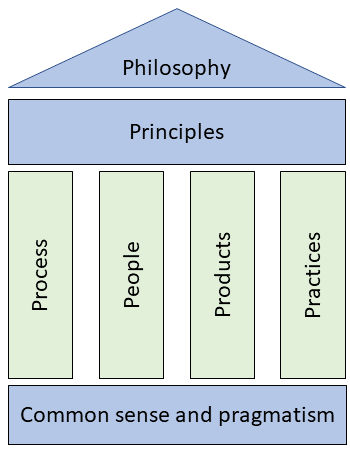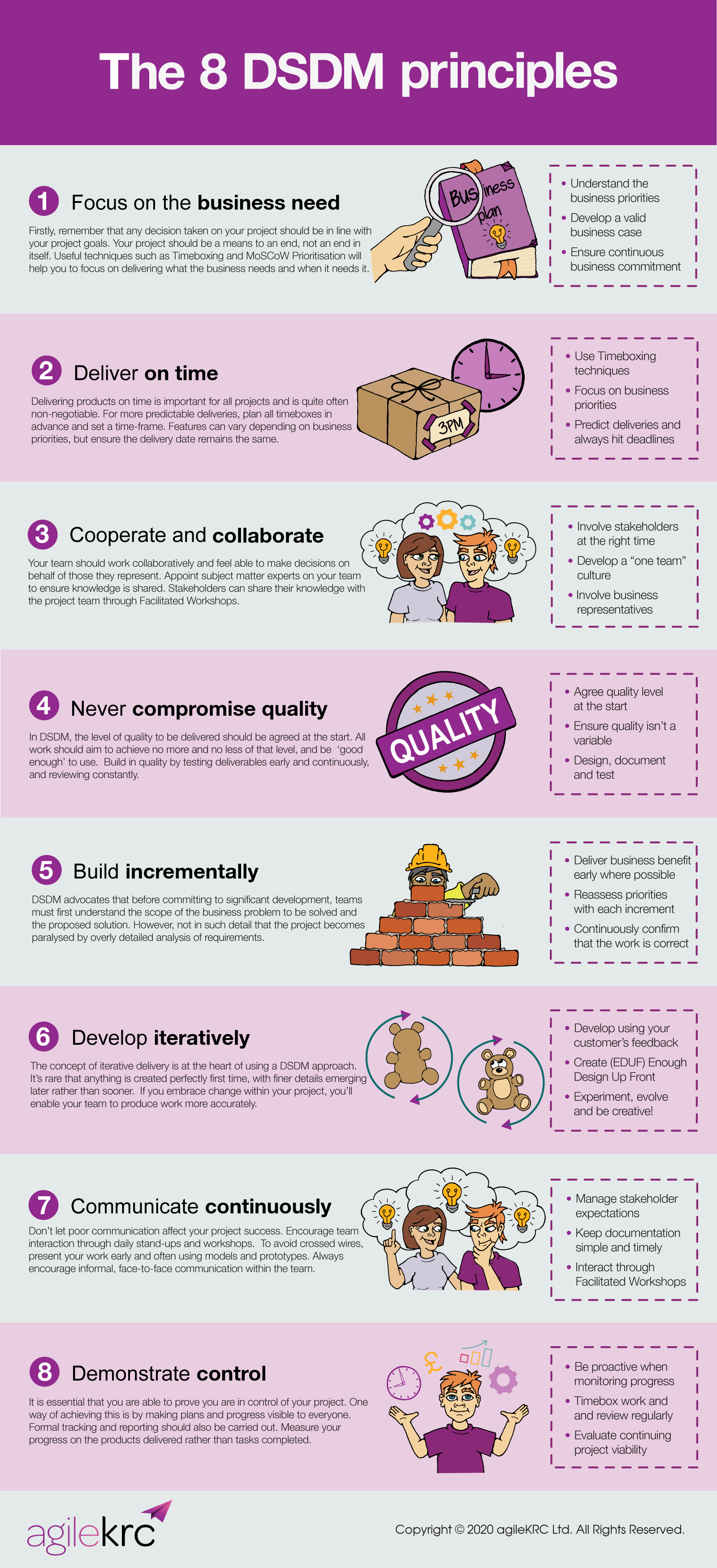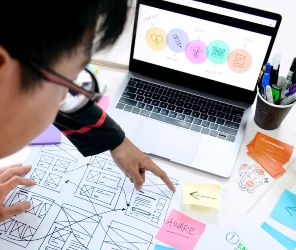
Overview
DSDM, or the Dynamic Systems Development Method, is often considered the best-kept secret in Agile methodology.
Originating in 1995, DSDM is the oldest Agile method and the sole method focused on managing Agile projects. After 2000, DSDM gained popularity among software developers seeking alternatives to rapid application development (RAD) approaches, which had scalability issues for team collaboration. By facilitating collaboration at scale, DSDM became one of the earliest Agile approaches adopted within the software development community.
DSDM played a role in the inception of the Agile Alliance and their Agile Manifesto in 2001. While DSDM’s philosophy and principles influenced the Manifesto for Agile Software Development, DSDM extends the concept of Agile beyond just software development.
Essentially, DSDM was Agile before Agile became mainstream!
The Evolution of DSDM
In 2007, the DSDM approach underwent a significant update, resulting in DSDM Atern. The name ‘Atern’ is derived from the Arctic Tern, a highly collaborative bird known for its long-distance travel capabilities — a fitting metaphor for the revamped DSDM method.
In 2014, the method was updated again due to confusion surrounding the term ‘Atern’. The decision was made to return to the original name, DSDM, which was already well-recognized. Consequently, DSDM and DSDM Atern are synonymous.
The DSDM Agile Project Framework
The 2014 rebranding of DSDM introduced the Agile Project Framework, which has since become the leading Agile approach that fulfills organizations’ dual needs for governance and rigor, as well as agility and flexibility.
The DSDM Agile Project Framework assists organizations in tackling common project issues like late delivery, cost overruns, or unsuitable final deliverables.
Introducing Agile Project Management (AgilePM)
DSDM became the first Agile framework to incorporate Agile project management capabilities, setting it apart from most other Agile frameworks. While Scrum focuses solely on product delivery during iterations, DSDM also addresses project management aspects.
Due to DSDM’s ability to cater to a variety of Agile needs, it was selected as the foundation for the rapidly growing AgilePM qualifications, accredited by APMG International and the Agile Business Consortium.
DSDM: An Agile Methodology
DSDM is an iterative Agile framework initially developed to enhance the efficiency of software project delivery. Like other Agile frameworks and approaches, DSDM emerged as a response to the problematic waterfall processes that dominated the software development industry in the late 20th century.
The Rise of DSDM
As Agile matures, DSDM continues to thrive. This growth is attributable to organizations seeking increased rigor and control when implementing Agile in situations where the ‘ideal Agile environment’ is not feasible.
DSDM addresses the needs of both simple product development projects with co-located teams and more complex projects involving multiple distributed teams working across different countries and time zones. DSDM can scale up to accommodate multiple teams working in distributed environments, a feature only recently offered by scaled Agile frameworks.
DSDM at a Glance
DSDM: Beyond the IT Realm
While the origins of DSDM, like most Agile methods, are rooted in the software development sector, Agile has evolved over the past decade, expanding beyond the confines of IT.
DSDM can be successfully employed in projects beyond software development, and even in various product development projects. By delivering a functional product increment at the conclusion of each timebox, DSDM facilitates early delivery of business value during the product development lifecycle.
Standalone or Combined DSDM Usage
The DSDM Agile Project Framework can be utilized either independently or in conjunction with other well-known project management methodologies, such as PRINCE2, MSP, and PMI.
DSDM is also an ideal complement for more narrowly focused Agile methods, like Scrum, ensuring coverage of the entire project lifecycle. Additionally, DSDM enables Scrum to scale beyond mere product development.
Anatomy of DSDM

DSDM is an Agile project framework comprising various components:
- philosophy
- principles
- process
- people
- products
- practices
- practicality and common sense.
Collectively, these elements reinforce a philosophy centered on delivering business benefits as early as possible, maximizing an organization’s return on investment (ROI).
DSDM’s emphasis on “practicality and common sense” may appear unusual to some. However, it is this adaptability that allows DSDM to sidestep the rigidness that occasionally plagues other Agile approaches.
DSDM operates on the fundamental premise that nothing is flawlessly constructed on the first attempt. Generally, 80% of a solution’s value can be delivered with 20% of the effort required to produce the complete solution.
By concentrating on business needs, DSDM supports projects that strategically align with the organization’s change portfolio requirements.
Core Tenets of DSDM
DSDM encompasses 8 fundamental tenets that embody its ethos, culture, and approach to work. These tenets must be consistently monitored and managed, as any compromise to a principle poses a risk to the successful implementation and completion of a project.
DSDM adheres to Agile principles, emphasizing delivery, effective communication, collaboration, and continuous delivery. The principles of DSDM serve to harmonize its practices within the Agile philosophy.
Understanding the foundational tenets of DSDM is crucial for those considering an Agile project management course, such as AgilePM®, which is built upon the DSDM methodology.
Next, we will delve into the 8 key principles of DSDM.
Principles of DSDM
1. Focus on the business need
- Grasp business priorities.
- Establish a solid business case.
- Facilitate ongoing business engagement.
All decisions made during your project must align with overarching project objectives. Projects should act as a means to achieve long-term business goals. Techniques such as MoSCoW and timeboxing aid in maintaining focus on delivering what businesses require, precisely when they need it.
2. Deliver on time
- Implement timeboxing.
- Prioritize effectively.
- Foresee deliveries.
Delivering products on schedule is often imperative. For predictable deliveries, pre-plan all timeboxes. Features may change, but delivery dates must always stay constant.
3. Cooperate and collaborate
- Encourage stakeholder collaboration.
- Concentrate on team building.
- Collaborate with business representatives.
Teams ought to work together and make decisions on behalf of the individuals they represent. Include subject matter experts in your team to ensure information dissemination. Stakeholders can contribute their expertise and experiences to project teams via regular workshops.
4. Never compromise quality
- Determine quality level from the outset.
- Maintain consistent quality.
- Document and test.
The level of quality to be achieved is agreed upon at the beginning. All work should strive to reach this predetermined level. Test deliverables early and continuously review.
5. Build incrementally
- Provide business benefits early.
- Reevaluate priorities with each iteration.
- Validate that the work is accurate.
DSDM asserts that teams must first comprehend the scope of the business issue to be resolved before committing to development. Avoid excessive detail in requirement analysis, which could paralyze development.
6. Develop iteratively
- Employ customer feedback.
- Develop Enough Design Up Front (EDUF).
- Adapt and innovate.
The notion of iterative delivery lies at the core of DSDM. It is uncommon for anything to be created perfectly on the first attempt; embracing change within your project is crucial for success.
7. Communicate continuously
- Manage expectations.
- Keep documentation straightforward.
- Engage through workshops.
Foster team interaction via stand-ups and workshops. Showcase your work frequently using models and prototypes. Consistently promote informal, face-to-face communication within the team.
8. Demonstrate control
- Take the initiative.
- Timebox work and conduct regular reviews.
- Assess project viability.
Enhancing project control can be achieved by making plans and progress transparent to all. Formal documentation procedures should also be followed. Gauge your progress based on the products delivered rather than tasks completed.
Processes
DSDM employs both iterative and incremental approaches. The most critical business requirements are addressed early on, while less vital ones are tackled later.
As an iterative methodology, DSDM allows business stakeholders to witness a developing solution, offer feedback, and request changes throughout the development process.
Phases
The DSDM process model encompasses 6 phases. A distinct pre-project phase and post-project phase set it apart from many other Agile methods, which typically focus solely on delivery.
The phases include:
- Pre-project.
- Feasibility.
- Foundations.
- Evolutionary development.
- Deployment.
- Post-project.
People
DSDM engages individuals from both the business and development sectors throughout the iterative and incremental life cycle.
All participants in a project are assigned specific roles and responsibilities, and they collaborate in timeboxes to keep the project on track.
Unlike other Agile methodologies, DSDM outlines the duties of the project manager role.
Practices
DSDM advocates for 4 primary practices.
Timeboxing
Similar to many agile methodologies, DSDM organizes work into fixed-duration periods (timeboxes), akin to sprints in Scrum. The goal is to produce a functional product at the conclusion of each iteration (timebox). Consequently, DSDM adopts both an incremental and iterative development strategy for product development.
Facilitated workshops
Facilitated workshops assemble project stakeholders for collaborative efforts in defining business requirements and fostering a shared understanding.
Modelling and iterative development
Modelling enables team members to visualize a business domain and enhance their comprehension of it. Modelling assists in creating diagrammatic representations of specific aspects of the system or business area under development.
To achieve an incremental working release of software following each iteration, DSDM depends on a brief feedback loop with the customer. It suggests employing the MoSCoW prioritization technique to determine the requirements for the team to address during a timebox. Requirements are generally captured in the form of user stories.
DSDM also utilizes prototyping. The objective is to construct something quickly, obtain feedback promptly, and identify issues sooner rather than later. The fundamental DSDM philosophy posits that discovering a flaw early allows for quicker adjustments and corrections.
MoSCoW prioritization
The MoSCoW prioritization method aids businesses in prioritizing requirements by categorizing them as Must have, Should have, Could have, or Won’t have within each timebox.
DSDM and Scrum
Many within the Agile community conflate Scrum with project management. Some even assert that Scrum is a project management methodology. However, it is not. Scrum is a development approach focused on enabling teams to collaborate on both project and non-project tasks to iteratively create products that deliver value to the customer.
Scrum does not address the pre-project phase nor the post-project phase. The pre-project phase necessitates evaluating a project’s viability, while the post-project phase involves considering how the solution’s benefits are measured and whether additional improvements are needed.
Conversely, DSDM does outline the pre-project and post-project stages and the duties of the project manager. DSDM is an agile project management framework, while Scrum is a product delivery framework. Nonetheless, Scrum can be employed in DSDM projects during the remaining four project phases.
DSDM infographic
The following infographic shows the DSDM principles in greater detail.

Summary
The DSDM Agile Project Framework is a well-established and tested approach for agile project delivery. It has been successfully employed in countless projects worldwide.
DSDM remains the sole agile project management framework to this day, consistently demonstrating its capacity to operate within and enhance existing corporate processes.
Dating back to 1994, its application in both IT and non-IT projects has led to significant productivity improvements, which have been independently confirmed by the UK Software Metrics Association.
For more details on how DSDM can support your Agile project delivery, or for information regarding agile project management training, please reach out to our team at agileKRC.
agileKRC has helped shape agile thinking by leading the teams that developed AgilePM® and PRINCE2 Agile®. We take a practical, success-oriented approach. We begin by taking the time to listen and understand your needs, before offering our real-world experience and expert guidance.













